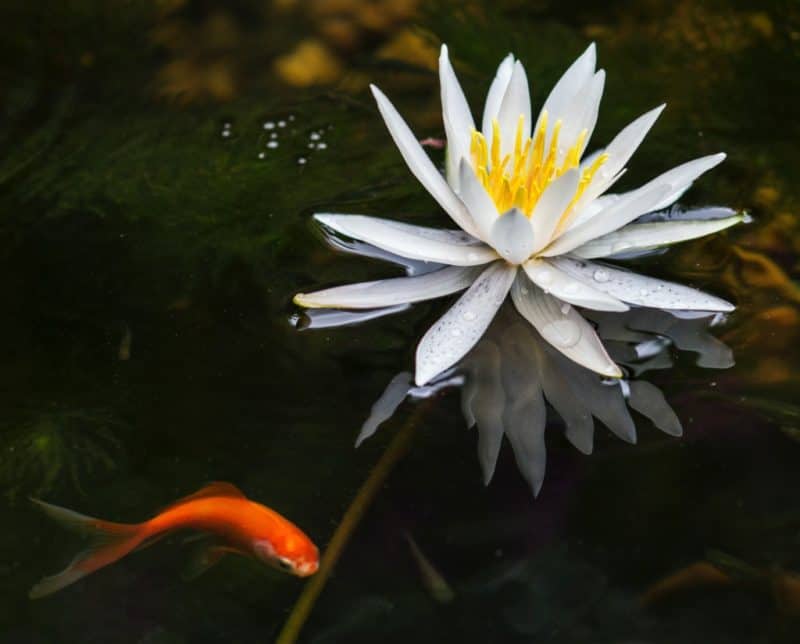Most living things need oxygen to survive, and ponds are typically chock full of living things. Plants and fish both need plenty of oxygen to thrive.
It is possible to have too much oxygen in a pond. Oxygen in a pond comes from the atmosphere, and from plants in the water. If the total amount of gasses in the water exceed 110 percent, then the aquatic life is at risk. Although it is rare, too much oxygen can cause gas bubble disease for fish.
What should you do if you think you might have too much oxygen in your pond? How can you tell how much oxygen is in your pond?
How Much Oxygen Should A Pond Have?
TDG is the measurement of the Total Dissolved Gasses in the water of your pond, such as oxygen and nitrogen. Your Total Dissolved Gasses can be high or low, and there are consequences either way. If your TDG is too high, there is a risk of harming the aquatic life in your pond.
Your fish could contract Gas Bubble Disease (GBD), which is caused by an over saturation of either oxygen or nitrogen (or both) in the water.
“Fish with GBD often exhibit loss of equilibrium, abnormal buoyancy and may float at the water surface. Fish may also exhibit violent head shaking, convulsions, flared opercula, release of excessive gas from buccal cavity, blindness and may die with the mouth open. . . Hemorrhage of gills, fins, skin, muscle, gonads, and intestinal epithelium can also occur.”
Source
This deadly disease is the main reason you should avoid having too much oxygen in your pond. If you do not have any aquatic life in your pond, then over saturating the water will only cause bubbles or possibly murky water. If you do have fish, then you should take precautions so you can keep them healthy and happy and avoid deadly diseases.
You can over saturate your pond’s oxygen content by having excessive aeration, or by rapid changes in temperature, although it is extremely hard to do. Having overly high levels of dissolved oxygen is rare, but should still be avoided. Having too low oxygen levels in your pond can also be dangerous for plant and animal life.
Dissolved Oxygen Readings in ppm (parts per million)
| Below 5 ppm | Very little life |
| Above 5 ppm | Large variety of life |
A healthy pond will have around 5 to 10 ppm dissolved oxygen (DO). Anything higher than 10 ppm will have consequences on aquatic life. Readings lower than 3 ppm will cause oxygen stress and is one of the leading causes of fish deaths.
The goal is to achieve equilibrium in your pond’s oxygen levels. You want to have 100% air saturation in your water. Levels will fluctuate based on temperature, time of day, or water depth, but you don’t want to go over 110% if you want to keep your fish healthy.
How Oxygen Enters Your Pond
When oxygen is introduced to the water, it dissolves, much like how sugar dissolves in water. The plants in your pond take in CO2 and release oxygen back into the water for the fish to breathe. Water is aerated, or moved around, through waves caused by wind, waterfalls, or water pumps. Aeration helps the oxygen to move through the water and keep oxygen levels consistent.
How to Measure Oxygen Levels in Your Pond
You can purchase your own oxygen level reader to check your pond.
Oxygen Levels Change Depending on Temperature and Depth
When temperatures are high, the oxygen level in the water is low, and when temperatures are low, the oxygen level in the water is high.
Colder water sinks and hotter water rises, so the oxygen levels will change depending on how deep the water is. When you measure the dissolved oxygen levels in your pond, make sure to test water near the surface and water near the bottom to make sure there is enough oxygen throughout the entire pond.
Algae and other plants near the surface of the water give off oxygen, making the oxygen levels near the surface typically higher than oxygen levels near the bottom of the pond. Bacteria at the bottom of the pond take in oxygen, which depletes the oxygen supply.
Oxygen levels will fluctuate based on the time of day you test your water. Throughout the day, oxygen levels will increase as plants go through photosynthesis and release oxygen into the water. At night, the fish and bacteria in the water use the oxygen, which will cause levels to decrease. Make sure to check the dissolved oxygen levels at different times of the day. Levels will be highest at dusk and lowest at dawn.
In order to maintain consistent dissolved oxygen in your pond, you need to make sure there is plenty of aeration and water flow. This can be done with water pumps, waterfalls, or by stirring the water manually. By making sure the water is mixed throughout the pond, you can ensure that the oxygen levels are consistent from surface to bottom.
